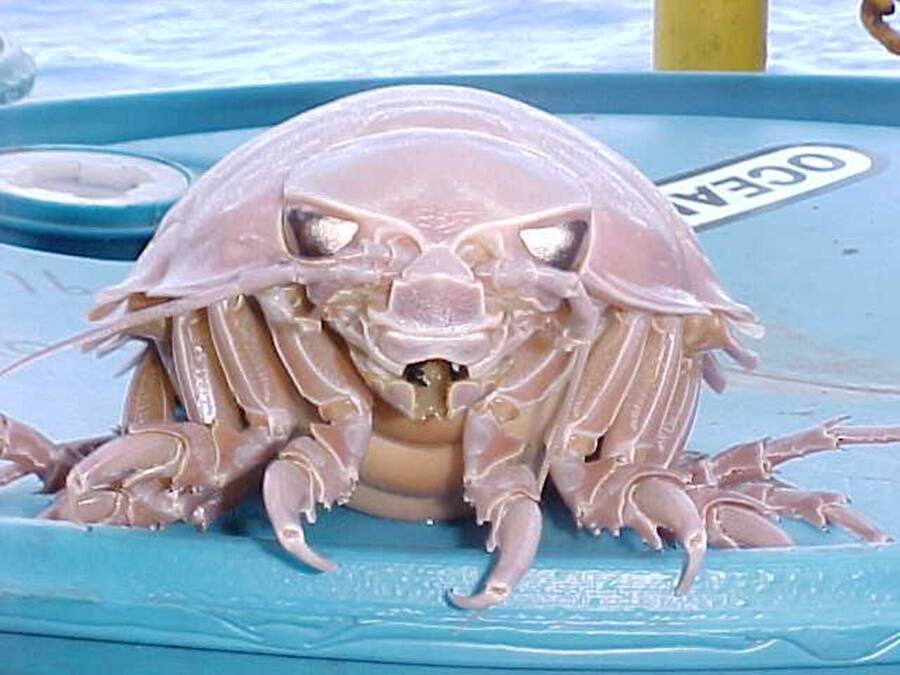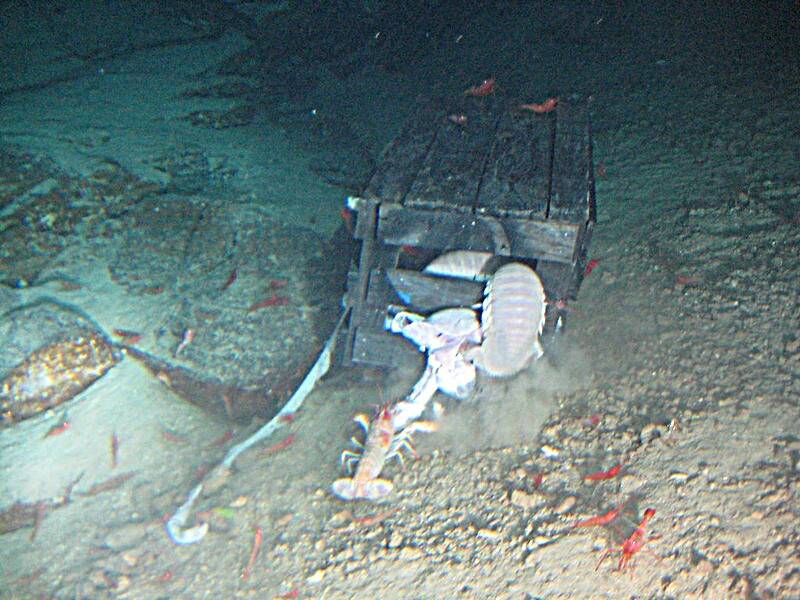Also known as Bathynomus giganteus, the giant isopod is the biggest isopod in the world. Famous for feasting on dead whales, fish, and squids, it's one of the creepiest sea creatures on the ocean floor.

Jesse Claggett/FlickrGiant isopods are the largest isopods on the planet.
Lurking on the ocean floor in deep, dark waters lies the giant isopod. It’s a sea creature so ready to feast that it could eat an entire whale on its own — as long as the whale is no longer alive.
While a giant isopod may resemble a creepy oversized bug or a dangerous underwater alien, it’s actually a deep-sea dwelling crustacean that plays an essential role in keeping the seafloor clean.
Its hefty appetite leads it to dine on sunken carcasses, which no doubt inspired its appearance in the Animal Crossing video game. In the game, it’s described as such:
“It’s most happy when dining on the carcasses of animals that have sunk to the bottom of the sea! This behavior has earned it a nickname… ‘the vacuum cleaner of the deep.'”
As its name suggests, the giant isopod is the largest isopod species in the world. But there’s more to these strange sea creatures than you might think.
What Is The Giant Isopod?
Although they might look the part, giant isopods are not bugs. They’re crustaceans that belong to the order Isopoda. This order includes several other animals that inhabit a wide variety of environments, so giant isopods have relatives both on land and in the water.
For instance, they’re related to crabs and shrimp as well as pillbugs and woodlice. Funnily enough, tiny pillbugs have an especially close resemblance to these large sea animals.
As their scientific name Bathynomus giganteus hints, giant isopods can grow to be quite large. While they typically reach a length between 7.5 and 14.2 inches, some “supergiant” isopods can grow up to 20 inches long.
One of the largest specimens on record was a 2.5-foot-long behemoth found in 2010. The giant isopod in question had hitched a ride on an underwater remotely operated vehicle (ROV) that had submerged 8,500 feet below the surface.
The technician who found it posted an image on Reddit, asking for people to help him identify the creature. Many said it resembled a roly-poly or a pillbug — and it’s not hard to see why.
Giant Isopods Look A Lot Like Bugs
Giant isopods have 14 creepy-looking limbs on their bodies, and they have two large, reflective eyes. Usually sporting a lilac or brown coloring, these bug-like creatures boast four sets of jaws. These come in handy as they feast on any and all carcasses that fall to the ocean floor, including sharks, whales, and squids.

Wikimedia CommonsThey have widely-spaced eyes that contain more than 4,000 individual facets and a reflective layer that helps them see in the dark.
Giant isopods typically lurk in the Pacific Ocean near Japan and in the South China Sea, but they’ve also been found in the waters of the Florida Keys. Because they prefer to live in deep waters, they went undiscovered until 1879, when French zoologist Alphonse Milne-Edwards encountered one in the Gulf of Mexico.
Since then, giant isopods have garnered a reputation as one of the weirdest and most fascinating deep-sea dwellers known to humankind.
Even though it ranks as the world’s largest isopod, it’s actually not the biggest crustacean in the world. That honor goes to the equally-terrifying Japanese spider crab, which also lives on the seafloor.
They’re Not That Aggressive

Deep Sea NewsOne of the largest giant isopods captured on record was a 2.5-foot-long behemoth in 2010.
More than 10,000 species of isopods exist worldwide, with 4,500 species found in marine environments. But there are only about 20 identified species within the genus Bathynomus.
Although their bug-like antennae and terrifying faces might make them seem like ferocious predators, giant isopods typically scavenge for animals that are already dead to sustain themselves. Whenever they eat live animals, they’re usually slow-moving ones like sponges.
Because its environment in the deep sea is a harsh place to live, the giant isopod has several special adaptations that help it survive.
Food is scarce down there, so giant isopods have a slow metabolism that keeps them in a state of semi-hibernation and allows them to thrive despite having little sustenance. In fact, giant isopods in captivity have been known to survive up to five years without a single meal.
They Are Scavengers Of The Deep Sea
But don’t get lulled in by the giant isopod’s mostly docile ways. According to Dee Ann Auten, an Aquarist II at the Aquarium of the Pacific, when these animals do eat, they gorge themselves until they can’t move.
“When they’re hungry, and they’re eating, definitely have a lot of food around them, because they’ll keep eating,” Auten explained. “They’ll eat a lot at one time and then they can go for a long time without eating. There’s a comic of one giant isopod eating a dead whale, and it eats the whole thing except for the bones. It’s sitting on its back like, ‘Ugh, I’m full now.’ That’s totally true!”

NOAAGiant isopods curl up like pillbugs when faced with a potential threat.
The giant isopod’s scavenging skills make it incredibly important for maintaining the health of the ocean floor. The deep-sea abyss would likely be filled with countless decaying carcasses without them. That’s why it’s so crucial for giant isopods to stay healthy and vital.
Even Their Babies Are Born Big
When they breed, female giant isopods use a pouch to carry about 20 to 30 eggs. They often burrow underneath sediment to protect their offspring. Giant isopods are thought to have the largest eggs of all marine invertebrates, each measuring more than half an inch in diameter.
Once they hatch, juvenile giant isopods don’t really go through a larval stage. They take on their adult form right away after being born about 3.4 inches long — and they’re only missing one pair of legs. As they grow into their full adult size, they also develop the last pair of legs along the way.
But even though these full-grown giant isopods look super fierce, their soft underbellies still make them vulnerable to threats. So these oversized crustaceans protect themselves by curling up into a ball — just like pillbugs, their tiny land-crawling cousins.
“If it’s eating something and a fish is trying to come over and take the food from them or bite their appendages, they’ll roll over to keep their food or to keep their soft organs underneath protected,” Auten said. “They would cover themselves so that nothing will attach to them. Or they’ll hide in a crevasse somewhere so that nothing can find them.”
How Do They Get So Big?

yoppy/FlickrScientists suspect their oversized bodies could be an adaptation to the harsh environment of the ocean floor.
For all that we know about the giant isopod, there is still much that we don’t know, including why this crustacean got so big in the first place. Most isopods that live in the ocean are minuscule, so why are the giant isopods so huge in comparison?
Marine biologists are still trying to figure out the answer to this question, but there are some possible explanations. One theory is that the giant isopod’s size is simply the result of larger cell sizes in its body. This may be an adaptation to the cold temperatures of its habitat.

Mark Yokoyama/FlickrGiant isopods attacking a bait box full of shrimp during an underwater survey.
Others believe this gigantism may help the creature withstand the extreme pressure under which it lives. Yet others have theorized that the size of this seafloor dweller increases its fasting ability, which is an important adaptation in a place where food is scarce.
However, these theories still don’t explain their variation in size and how some of them can reach the “supergiant” size.
While there is still much to be learned about the giant isopod, we do know that these seafloor dwellers are a vital part of our oceans.
Next, check out the peculiar life of the coconut crab and meet the mola-mola, the rhino-sized floating fish head sunbathing on our ocean’s surface.





